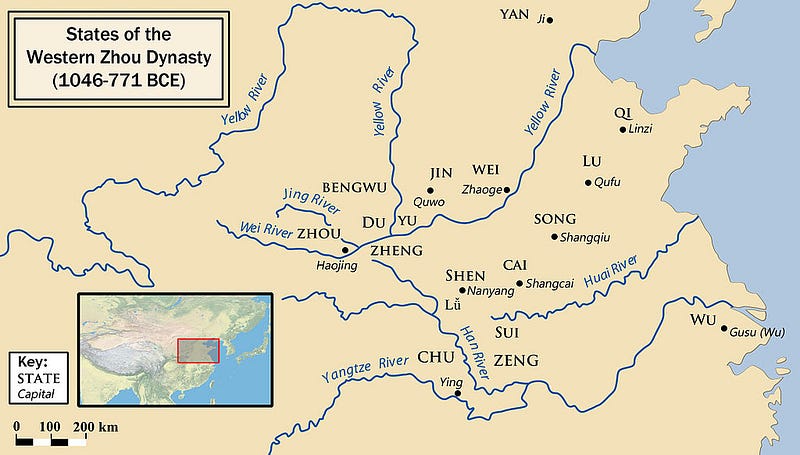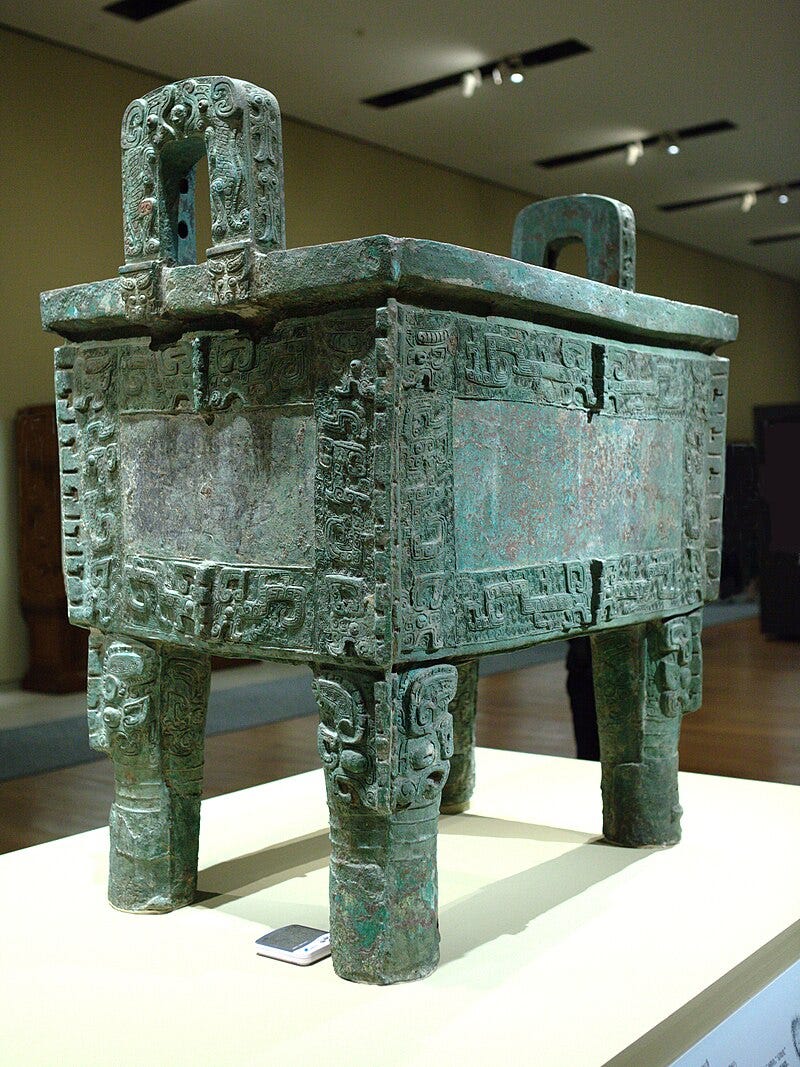Unraveling the Mystery of the Nine Tripod Cauldrons of Ancient China
Written on
Chapter 1: The Legend of the Nine Cauldrons
The tale of the Nine Tripod Cauldrons, known in Chinese as Jiu Ding, stands as one of the most intriguing enigmas of ancient China. Although numerous historical texts reference these cauldrons, their actual existence remains unconfirmed. These bronze vessels represented the sovereign's power and played a crucial role in ritual offerings. However, following the decline of the Zhou dynasty, the last of the three primary Chinese dynasties, these cauldrons seemingly vanished from history.
One legend suggests that a dragon spirited them away into a river, leaving their fate shrouded in mystery. The allure of the Nine Tripod Cauldrons continues to fascinate both historians and enthusiasts alike. Will we ever uncover their secrets? And what made these artifacts so revered in ancient Chinese culture?
To delve deeper into this mystery, I collaborated with Dr. David Miano, a Professor of Ancient History at the State College of Florida, for his YouTube channel, World of Antiquity. I have included the video link at the end of this exploration.
Let's embark on a journey to unravel the secrets of the Nine Cauldrons!

The Nine Tripod Cauldrons: Historical Context
The Nine Tripods were constructed from bronze and sought after by various ancient Chinese dynasties until their disappearance in the 3rd century BC. The earliest reference to these cauldrons can be traced back to a speech by Wangsun Man, documented in the Zuo Zhuan, which is a commentary on the Spring and Autumn Annals.
The Spring and Autumn Annals, a foundational text in ancient Chinese literature, chronicles events from 771 BC to 476 BC. The significance of the Nine Tripods became evident during a pivotal moment in 605 BC when a warlord from the state of Chu besieged Luoyang, the Zhou capital. In an effort to appease the warlord, King Zhou dispatched Wangsun Man with lavish gifts. When the warlord inquired about the weight of the Nine Tripods, Wangsun Man's response revealed their profound importance in ancient society.
Wangsun Man remarked, "The Tripods do not matter; virtue does." He elaborated that the cauldrons were initially crafted to symbolize the unity and morality of the Xia dynasty, the first centralized state in China. This exchange illustrates that the cauldrons were not merely physical objects; they represented the moral fabric of governance and authority.
The Importance of the Nine Cauldrons
The first video, Hidden Ancient Secrets, discusses the broader context of ancient artifacts, including the Nine Tripod Cauldrons. Their significance extends beyond mere functionality, serving as emblems of power and legitimacy.
The Nine Tripod Cauldrons were crafted to commemorate the Xia dynasty's establishment, led by Yu the Great, who is celebrated for his flood control efforts around 2070 BC. Yu's initiatives allowed for political stability and tribute collection from nine provinces, which were then transformed into the legendary cauldrons.
Wangsun Man's reference to “things” alludes to the acknowledgment of rulers' loyalty to Yu, marking them as virtuous in the eyes of the populace. The cauldrons, weighing up to 30,000 catties each (approximately 16.5 tons), became symbols of the divine right to rule.
Throughout the Shang dynasty, strict regulations governed the usage of these cauldrons, with only the king entitled to use all nine, underscoring the cauldrons' role in affirming centralized authority.
The Weight of the Cauldrons and Its Symbolism
The weight of the cauldrons held significant implications for understanding the nature of governance in ancient China. During Wangsun Man's discourse, he emphasized that when a ruler was virtuous, even the smallest vessels would carry weight, symbolizing authority and legitimacy. Conversely, in times of corruption, the largest vessels would feel light, indicating a loss of power.
This dialogue reflects the idea that the cauldrons served as a tangible measure of a dynasty's strength and the ruler's moral standing. The inquiry into the cauldrons' weight by the warlord was not merely a question of curiosity but a strategic assessment of the Zhou kingdom's stability.
The second video, Ancient Mysteries Iceberg - The Complete Saga, elaborates on the broader implications of ancient artifacts, including the Nine Tripod Cauldrons, in shaping historical narratives.
Evolving Symbolism: From Ritual to Political Power
As the Zhou dynasty progressed, the function of bronze vessels transitioned from ceremonial objects to instruments of political authority. This shift is evidenced by the inscriptions found on the vessels, which often recorded official appointments.
Historians have classified these vessels as "investiture bronzes," signifying the authority conferred by the king upon his officials. Thus, the Nine Cauldrons may have embodied not only centralized power but also the transfer of political legitimacy.
The Fate of the Nine Cauldrons
The ultimate fate of the Nine Tripod Cauldrons remains uncertain. In 290 BC, the Qin dynasty attempted to seize them, but their efforts were thwarted by Zhou political maneuvers. Following the Zhou's fall in 256 BC, historical records suggest the cauldrons were lost in the Si River.
Sima Qian, a noted historian, recounts a fantastical tale involving Qin Shi Huang, who sought the cauldrons after unifying China. Despite his efforts, a dragon intervened, ensuring the cauldrons' eternal disappearance.
Archaeological evidence, such as the discovery of the Houmuwu ding, offers insight into the cauldrons' potential appearance and significance. While it remains unclear whether this cauldron was one of the original Nine, it reflects the craftsmanship and cultural importance of such artifacts.

The ancient world is rife with mysteries, and the fate of the Nine Tripod Cauldrons is among the most captivating. As we continue to explore the legacies of past civilizations, who knows what secrets may yet be unveiled?
If you have a passion for the enigmas of ancient cultures, consider exploring the story of the Sea Peoples, who are often blamed for the Bronze Age Collapse.
Who Were the Mysterious Sea Peoples Blamed for the Bronze Age Collapse?
They came from the sea, laid waste to civilization, and disappeared!
Your interest in historical mysteries fuels further exploration and inquiry. If you enjoy these tales, please support my work by subscribing to Medium using my referral link for unlimited access to a wealth of stories.
References
- Hung Wu, Monumentality in Early Chinese Art and Architecture (Stanford: Stanford University Press, 1995).
- Li Song, Chinese Bronze Ware (Cambridge: Cambridge University Press, 2011).
- Watson, Burton (1993), Records of the Grand Historian by Sima Qian, Columbia University Press.
- Anne Birell (2000), Chinese Myths, British University Press.